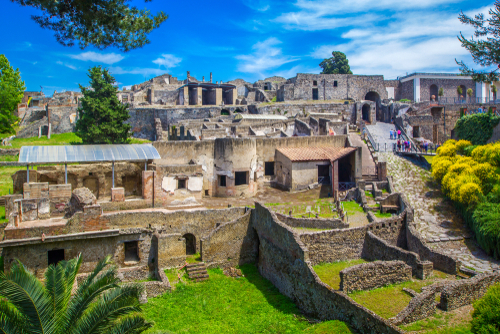Location Information
Luxury Pompeii Tour
Pompeii
Pompeii, located in the Gulf of Naples and on the slopes of the Vesuvius volcano, was one of the largest and most splendid cities of the Roman era. An ancient city of the Oscan settlement, it was later inhabited by the Samnites and then, starting from the first century BC, conquered by the Romans.
Pompeii was buried by the Vesuvius eruption in 79 AD. The city was buried by lava following the eruption of the volcano. The lava and ash were a sort of cover that allowed the city to maintain itself over the centuries and to be protected from the elements.
Today, it is possible to visit the ancient Pompeii tour and walk on its streets, which are overlooked by houses. Inside them, rich frescoes that adorned the walls and ceilings are still visible, and archaeologists have even managed to find the bodies of those who perished in those circumstances.
During 2020, an exceptional discovery has emerged: the bodies of two other men, a lord, and his slave, have been found. Ancient Pompeii has not yet been unearthed in its entirety and excavations continue to this day.
Pompeii is known as the city where there is one of the most important archaeological sites in the world.
Top Attractions for Pompeii Tour
The Shrine of Pompeii
The history of the Shrine of Pompeii is the story of a dream that has involved thousands of believers.
Construction began on May 8, 1876 under the direction of Antonio Cua, who offered his work for free to start work on the Sanctuary. Over the centuries, it was necessary to expand the Sanctuary, because the original structure was no longer able to contain the numerous faithful who went to venerate the painting of the Virgin.
Inside the Shrine, there is the painting of the Virgin of the Rosary with the Child and Saint Dominic and Saint Catherine of Siena on the sides. It is kept on the main altar and has a gilded bronze frame surrounded by the fifteen mysteries of the Rosary painted by Vincenzo Paliotti; this canvas has become the object of deep veneration all over the world.
The House of the Faun
The House of the Faun, a Roman villa of almost 3000 square meters, is one of the main attractions of Pompeii. It owes its name to the bronze statuette of a dancing faun placed in the impluvium. It is one of the richest and most famous houses in the whole of Pompeii and extends over about 3000 square meters with a portion intended for the owners and one for the servants. The rooms, all richly frescoed, overlooked the well-tended gardens. Statues, frescoes, and spectacular mosaics undoubtedly gave the measure of the power and opulence of the rich inhabitants of that period.
The Amphitheater of Pompeii
The Amphitheater of Pompeii is the oldest building for gladiator shows that has come down to us. It was built shortly after 70 BC by the will of the two magistrates Caius Quinctius Valgus and Marcus Porcius. The building does not have the basement and is characterized by two entrances.
The upper part (summa cavea) was reserved for women, according to an Augustan ordinance. It was accessed through the external stairs of the building. While the magistrates sat on the lower steps.
Gladiators were popular at the time. As evidence of the importance of gladiator shows, there are the numerous inscriptions found on the houses of the city that advertised the events.
Include this location among many others in your very own tailor-made itinerary with Classic Amalfi Coast. Inquire with us for your free personalized vacation quote.
Gallery



